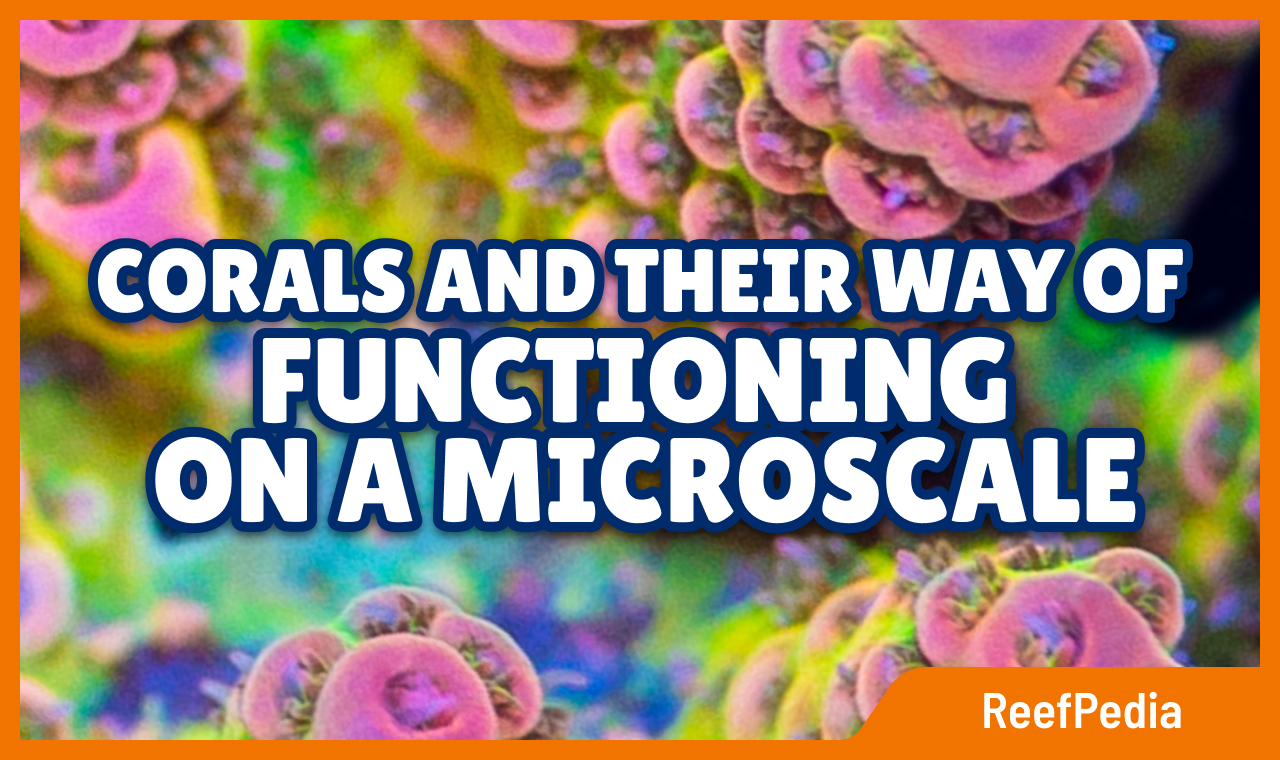Symbiosis of corals and algae
Zooxanthellae – belonging to Symbiodinium – are yellow algae, rich in carotenoids, nested in coral cells. Numerous interactions occur between them and the host, in which the algae provide the corals with many additional nutrients. It can be as much as 30 to 90% of the products of photosynthesis – depending on the species. The algae symbiotic with the corals have lost their cell wall, and unknown factors secreted by the coral cells make the zooxanthellae cell membrane highly permeable. Compounds such as sugar derivatives – glycerol, fatty acids, amino acids and other products of photosynthesis permeate the membrane.
In a situation where the coral “hunts” some small prey – which becomes a source of protein, phosphates and sulfur compounds – the products of metabolism are not excreted into the environment, but become a nutrient for symbiotic algae. If we experimentally deprive the coral of algae, then these products will be excreted outside. Algae, in return for this fertiliser, convert waste products containing phosphorus and nitrogen into molecules usable by corals, such as amino acids. Another waste product – given off by coral respiration – CO2 stimulates photosynthesis in zooxanthellae. It is a system in which nothing is wasted, because the particles are processed in a closed circuit.
Zooxanthellae are stripped of their protective cell wall and benefit from coral protection. Host cells protect them from environmental shock, being preyed upon by predators, toxins, and overexposure to light by producing photoprotective substances.
Zooxanthellae stimulate the formation of a calcareous skeleton that protects most corals. In the photosynthesis carried out by them, CO2 is taken from the water, which is present in the form of bicarbonate ions (HCO3-). In the presence of calcium ions, the by-product of carbon dioxide uptake is the deposition of calcium carbonate. This complements the skeletalization mechanisms of the animals themselves.
This symbiosis involves many different types of zooxanthellae that are adapted to different light levels, so different proportions of algae occur in different locations on the coral. If we change the position of the coral, e.g. by moving the previously less exposed part to the more exposed to light – these proportions change along with the changing environment. An extreme example of this adaptation is coral reef bleaching, where corals shed their algae under stress, looking for those that are better adapted.
Zooxanthellae also enter into symbiosis with coral-dwelling bacteria, so that it is very difficult or even impossible to separate them from each other. It was shown that some cultures deprived of their bacteria died, and when symbiotic bacteria, such as a-Proteobacteria, were added to the culture, their growth returned to normal. This is because cross-feeding within corals also occurs between bacteria and zooxanthellae.
Symbiosis with bacteria, fungi and archaea
Corals are considered one of the most complex microbial biospheres, containing thousands of species-specific bacterial phylotypes.
Microorganisms inhabit coral tissues and layers of secreted mucus. They include complex communities of bacteria, archaea, viruses and other microbes that may be specific to a particular coral species. Due to the complexity of the microbial population and their difficulty in laboratory cultivation, it is hard to clearly indicate what interactions occur between them and corals. In genetic studies, Proteobacteria are the dominant bacteria, other bacteria that are also common include members of the phyla Bacteriodetes, Firmicutes, Actinobacteria and Cyanobacteria. The composition of the microflora is very variable, varying between individuals and the age of the colony. It is also influenced by many external factors. Changing environmental conditions can quickly change the composition and abundance of microorganisms associated with corals. Changes in the microbiome could help corals adapt to changing environmental conditions much faster than mutation and selection of the host itself.
Different microorganisms are found in different places in corals, the location of specific bacteria in different cell layers may suggest that some of them may play an important role in nutrient uptake by corals. In the “epidermal” cell layers, a high presence of g-proteobacteria was found, and colonies of Endozoicomonas were also located in different cell layers. Members g-proteobacteria, Cyanobacteria, Flavobacteria and Firmicutes have been isolated from the coral’s stomach cavity.
It is likely that the specific composition of the coral slime microflora may contribute to increased resistance to pathogens. This system is not yet well understood, and it is not known whether symbiotic bacteria produce antibiotics (up to 30% of mucus bacterial isolates have been shown to produce a broad-spectrum antibiotic), or whether coral-secreted compounds contribute to favoring certain groups of microorganisms. There is great variability in the production of antibiotics by individual corals. There are also studies showing that with increasing temperature, the number of pathogens increases, at the expense of more beneficial microorganisms.
To obtain the necessary nutrients, corals acquire them either from the environment or from the microorganisms that live with them. Many of these components (e.g. lipids, sterols and trace metals) pass freely between the host and the cooperating microorganisms. Corals can also regulate their microbial communities to obtain essential vitamins such as B12. Because they are unable to synthesize these vitamins.
Participation of microflora in the circulation of elements
Research on coral reefs has shown that microorganisms degrade the organic compound dimethylsulfoniopropionate (DMSP) and its products dimethyl sulfide (DMS) and acrylic acid. The types of coral-associated bacteria such as Spongiobacter, Pseudomonas, Roseobacter and Vibrio spp. are able to metabolize these compounds, providing evidence for the role of coral-associated bacteria in the sulfur cycle.
Microorganisms involved in the nitrogen cycle are ubiquitous and permanent members of the coral microbiome. The coral’s heterotrophic nutrition can meet a large portion of its nitrogen requirements. In addition, corals obtain nutrients from symbiotic algae of the genus Symbiodinium. In this relationship, phototrophic zooxanthellae provide the host with the products of photosynthesis. However, these products have a high C:N ratio and therefore require additional nitrogen supplementation to sustain coral growth. Symbiotic algae benefit from inorganic nutrients that are released by corals as waste products. While both corals and their associated Symbiodinium are capable of fixing ammonia, algae account for most of the uptake of dissolved inorganic nitrogen from the environment, mainly in the form of ammonia (NH4+) and nitrate (NO3-). This nitrogen, together with nitrogen compounds from the host, is either stored by the algae or used in their metabolism and may be partly returned to the host as organic nitrogen compounds, for example amino acids.
Too high a nitrogen concentration can cause phosphate starvation and ultimately increase the likelihood of loss of symbiotic zooxanthellae. In this case, nitrogen cycling by coral-associated microorganisms may be an additional mechanism contributing to the stabilization or, conversely, destabilization of the coral-algae symbiosis. Microbiome-driven nitrification used almost exclusively ammonium from coral metabolism, a process that occurred at a rate that effectively competes with autotrophic ammonium uptake. Bacteria associated with the nitrogen cycle, living in coral tissues and their surface, may be a way to regulate nitrogen in this system.
Phosphorus (P), an essential component of all living organisms, is considered the most limiting nutrient in marine ecosystems. To optimize its uptake, the corals here benefit from a symbiosis with algae that recycle the waste of the animal host and convert dissolved inorganic nutrients into organic molecules, making them bioavailable to the host. Corals feed heterotrophically or absorb dissolved organic nutrients. Symbiotic dinoflagellates are photoautotrophs, and rely on the uptake of nitrogen and phosphorus in dissolved inorganic forms. They also benefit from the phosphorus and nitrogen-rich metabolic waste of their hosts. Otherwise, the nutrients would be excreted by the animal and lost in the surrounding water. In return, the corals benefit from the large amount of photosynthesis products of the symbiotic algae. Nutrients consumed by corals are mineralized to PO4, which is consumed by zooxanthellae, serving as building blocks for their cells, and some is part of organic molecules returned to the host.
About Author

Agata Łobocka
I’m an industrial biotechnologist by education. I’m fascinated by microbiology and the influence of the microworld on everything that surrounds us. Professionally, I create products based on microorganisms that are more environmentally friendly than classic, popular preparations.
Before I started my adventure at Reef Factory, I was widely interested in freshwater aquaristics. In the world of marine aquaristics, I was most fascinated by the huge network of dependencies created by corals with their symbiotic microorganisms. These relationships perfectly show that organisms need their microfriends to function in health, and every element of this relationship benefits from it.
Privately, I’m interested in new technologies that counteract the negative impact of man on the environment. I'm also into self-development, cognitive science and popular science literature. I like to spend my free time actively, surrounded by beautiful nature.
I hope that my articles from the Biology section o ReefPedia will help you better understand the life in a marine aquarium.

